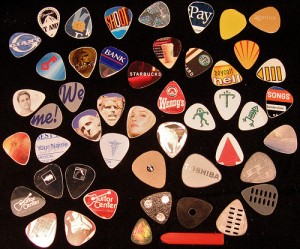TheGuitarLesson.com
This post appeared first at Guitar Pick Tips and Guide on TheGuitarLesson.com, thanks for reading.
The guitar pick (aka plectrum) you use is one of the most overlooked parts of most beginner guitar lessons, so I want to share some guitar pick tips with you. Believe it or not, the guitar pick you use makes a huge impact on both the tone you get from your guitar, and the ease of which you can play a specific song or genre.

So many picks, so little time…
Your guitar plectrum is the main point of contact between you and the guitar (unless you are watching our fingerpicking guitar lessons of course :-)). A given type of pick might work better for a particular musical situation, depending on the tone you want to hear and the genre you are playing.
Of course, first thing’s first, learn how to hold a guitar pick. Once it doesn’t fly out of your hand on the third strum anymore, you can start experimenting with picks of different material and gauge, the results will be very audible and often lead to the easier playing of a given song.
Here are some tips on how to choose the proper guitar pick in any given situation:
- Thinner picks work best if you’re strumming chords, since they provide less resistance as the pick glides across the strings. Of course, the disadvantage of thinner, lighter picks is that they flap and bend, making them unsuitable for precision picking of lead guitar solos.
- Medium and heavy guitar picks help with pinch harmonics, single note picking, pick slides, and more. The thicker the pick, the better it will be for single note lines that require precise and fast picking. Sine thicker picks don’t bend, they give you more control, especially if you are playing lead guitar with fast, single-note riffs. Also, the thicker the pick, the louder it’s volume will be.
- Picks made of nylon will last longer than their plastic counterpart. Plastic picks sometimes break while playing, in contrast with nylon picks, which are more durable.
- Picks come in a variety of sizes which you can experiment with. Find a size and shape of pick that is comfortable for your hand.
- Don’t be afraid to change picks during a session, according to what you are playing.
- I prefer the Jim Dunlop Gels Standard for all around playing (just like Darryl Jones from the Rolling Stones). I’ve been using these picks since I can’t even remember when, since I like their brighter sound. If you want a darker tone, try a Tortex pick from Dunlop.
It is also important to note that if you want replicate a given guitar song, don’t just try to replicate the tone on your amp and guitar hardware settings, read up on what kind of pick the artist uses. For example, Eric Johnson uses Jim Dunlop Jazz II nylon picks, Slash uses vaious Tortex picks from Dunlop, Ritchie Blackmore carves his own diamond shaped picks out of heavy plastics, etc.
Go ahead and experiment with different types, sizes, and gauges of picks, it’s a relatively small cost and will advance your skills by discovering the different tones you can achieve through using different types of picks.
TheGuitarLesson.com is your source for beginner guitar lessons.
Read More
This article is from an external source and may contain external links not controlled by Empeda Music.

